PressureSensor压力传感器
压力传感器知识点总结
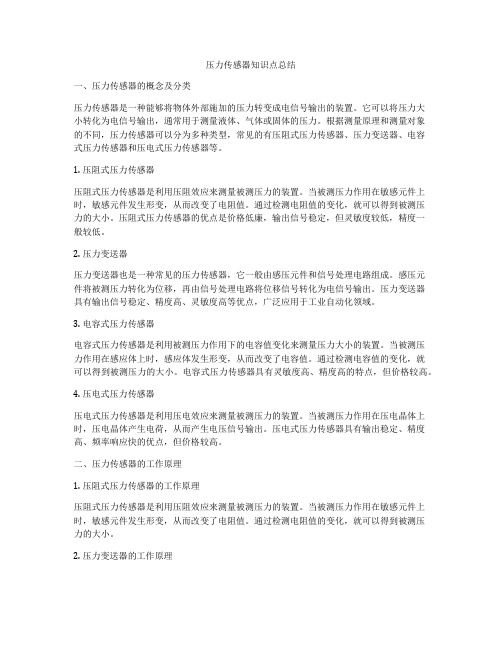
压力传感器知识点总结一、压力传感器的概念及分类压力传感器是一种能够将物体外部施加的压力转变成电信号输出的装置。
它可以将压力大小转化为电信号输出,通常用于测量液体、气体或固体的压力。
根据测量原理和测量对象的不同,压力传感器可以分为多种类型,常见的有压阻式压力传感器、压力变送器、电容式压力传感器和压电式压力传感器等。
1. 压阻式压力传感器压阻式压力传感器是利用压阻效应来测量被测压力的装置。
当被测压力作用在敏感元件上时,敏感元件发生形变,从而改变了电阻值。
通过检测电阻值的变化,就可以得到被测压力的大小。
压阻式压力传感器的优点是价格低廉,输出信号稳定,但灵敏度较低,精度一般较低。
2. 压力变送器压力变送器也是一种常见的压力传感器,它一般由感压元件和信号处理电路组成。
感压元件将被测压力转化为位移,再由信号处理电路将位移信号转化为电信号输出。
压力变送器具有输出信号稳定、精度高、灵敏度高等优点,广泛应用于工业自动化领域。
3. 电容式压力传感器电容式压力传感器是利用被测压力作用下的电容值变化来测量压力大小的装置。
当被测压力作用在感应体上时,感应体发生形变,从而改变了电容值。
通过检测电容值的变化,就可以得到被测压力的大小。
电容式压力传感器具有灵敏度高、精度高的特点,但价格较高。
4. 压电式压力传感器压电式压力传感器是利用压电效应来测量被测压力的装置。
当被测压力作用在压电晶体上时,压电晶体产生电荷,从而产生电压信号输出。
压电式压力传感器具有输出稳定、精度高、频率响应快的优点,但价格较高。
二、压力传感器的工作原理1. 压阻式压力传感器的工作原理压阻式压力传感器是利用压阻效应来测量被测压力的装置。
当被测压力作用在敏感元件上时,敏感元件发生形变,从而改变了电阻值。
通过检测电阻值的变化,就可以得到被测压力的大小。
2. 压力变送器的工作原理压力变送器一般由感压元件和信号处理电路组成。
感压元件将被测压力转化为位移,再由信号处理电路将位移信号转化为电信号输出。
传感器测量的名词解释
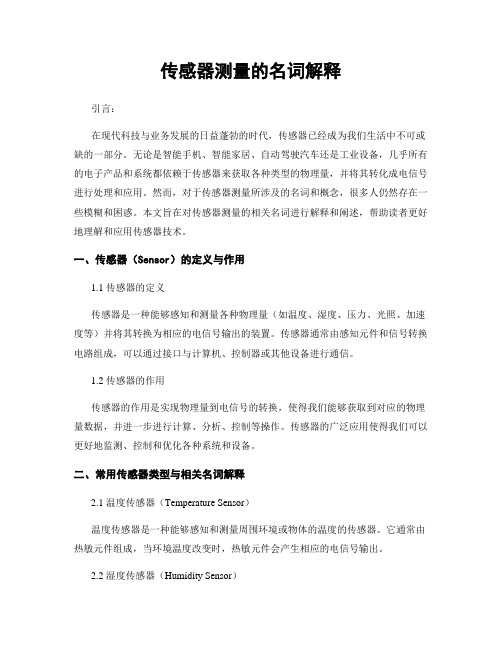
传感器测量的名词解释引言:在现代科技与业务发展的日益蓬勃的时代,传感器已经成为我们生活中不可或缺的一部分。
无论是智能手机、智能家居、自动驾驶汽车还是工业设备,几乎所有的电子产品和系统都依赖于传感器来获取各种类型的物理量,并将其转化成电信号进行处理和应用。
然而,对于传感器测量所涉及的名词和概念,很多人仍然存在一些模糊和困惑。
本文旨在对传感器测量的相关名词进行解释和阐述,帮助读者更好地理解和应用传感器技术。
一、传感器(Sensor)的定义与作用1.1 传感器的定义传感器是一种能够感知和测量各种物理量(如温度、湿度、压力、光照、加速度等)并将其转换为相应的电信号输出的装置。
传感器通常由感知元件和信号转换电路组成,可以通过接口与计算机、控制器或其他设备进行通信。
1.2 传感器的作用传感器的作用是实现物理量到电信号的转换,使得我们能够获取到对应的物理量数据,并进一步进行计算、分析、控制等操作。
传感器的广泛应用使得我们可以更好地监测、控制和优化各种系统和设备。
二、常用传感器类型与相关名词解释2.1 温度传感器(Temperature Sensor)温度传感器是一种能够感知和测量周围环境或物体的温度的传感器。
它通常由热敏元件组成,当环境温度改变时,热敏元件会产生相应的电信号输出。
2.2 湿度传感器(Humidity Sensor)湿度传感器是一种用来感知和测量周围环境或物体的湿度水平的传感器。
它通常使用电容、电阻或共振频率等原理来感知和测量湿度,并将其转换为对应的电信号输出。
2.3 压力传感器(Pressure Sensor)压力传感器是一种用来感知和测量周围环境或物体的压力的传感器。
它通常采用电阻、电容、压电效应等不同原理来感知和测量压力,并将其转换为相应的电信号输出。
2.4 光照传感器(Light Sensor)光照传感器是一种用来感知和测量周围环境光照强度的传感器。
它通常使用光敏元件,如光敏二极管或光敏电阻等进行感知,并将光照强度转换为相应的电信号输出。
Amphenol NovaSensor NPA压力传感器说明书

Healthcare Application Spaces
• Sleep apnea - CPAP • Critical care ventilators • Anesthesia machines • Compression therapy • Air mattresses • Wound management • First responder equipment • Blood pressure
NPA Application Guide:
• /en/component/edocman/312-novasensor-npa-applicationguide/download?Itemid=8007%20%27
NPA Product Brochure:
• Analog Output: • 0.5-3.0Vdc output (3.3Vdc supply) • 0.5-4.5Vdc output (5.0Vdc supply) • 100mV output (5.0Vdc or 1.5mA supply)
• Fast Response Time • <0.5ms sample time for I2C NPA • <2 ms sample time for Analog NPA
6/ Copyright © 2015 Amphenol. All rights reserved.
/en/products/pressure-mems/mems-sensors/3161npa-pressure-sensor
Lowest profile SOIC Package
(3.3Vdc supply) (5.0Vdc supply) (5.0Vdc or 1.5mA supply)
Honeywell 压力传感器(Jackson Union压力传感器)产品说明书

(casing and cementing) are vital oil and gas processes that utilize pressure sensors for measurement and monitoring functions.APPLICATIONSHoneywell Wing Union pressure sensors (also known as Hammer Union pressure sensors outside of the United States) are widely used by oil and gas companies to measure pressure level changes in media circulation systems.Oil Mud LoggingFor example, oil mud loggingapplications (see Figure 1) require a series of pressure sensors to be connected to the drilling apparatus and installed in specialized equipment to monitor or “log” the drill’s activity. Logging While Drilling (LWD) and Measurement While Drilling (MWD)pump into the well), mud pumps (for pressure monitoring of incoming and outgoing media to protect the mudpump and drill bit), and return line choke manifold (for pressure monitoring of the return line carrying the mud plus cuttings).During the mud logging process, pumps send drilling media throughout the circulation system, down to the drilling bit, and then return the bit’s cuttings to the surface for analysis and disposal. Honeywell’s wing union/hammer union pressure sensors help detect pressure level changes in the media circulation system, which can indicate changing conditions being encountered downhole by the drill bit, thus allowing the operator to quickly make adjustments to the drilling mixture pressure or drilling process as needed.today’s oil and gas industry, used for many types Models 434, 435, 437 Wing Union/ Hammer Union Pressure TransducerPRESSURE SENSORS FOROIL & GASApplication NoteFracturing, Acidizing, and Cementing Honeywell’s Wing Union/Hammer Union pressure sensors are also used during fracturing, acidizing, and cementing applications for similar pressure monitoring and control purposes.SOLUTIONSHoneywell Wing Union/Hammer Union Pressure Sensors are built ruggedand oilfield tough to stand up to the rigorous demands of oil and gas drilling applications and environments. They have the sensitivity to ensure precise, reliable measurements every time, optimize drilling operation, reduce downtime, and maximize productivity. Durable ConstructionModels 434, 435, and 437 are constructed on Honeywell’s time proven all-welded, one-piece design, with the sensor diaphragm and Weco® 1502, 2202 Wing Union compatible fitting form factor machined as one part. This one-piece design provides a hermetically sealed unit, reducing the chanceof media leakage into the sensitive electronic components, and increasing overall reliability. The isolated, pressure sensing diaphragm minimizes zero-shift during hammer up and also eliminates long term, signal drift in the field, making it easier to install and providing reliable pressure readings over time.The sensor diaphragm is machined from Inconel® 718, which provides additional durability with highly abrasive and corrosive media, and is weldedto the main stainless steel body. The stainless steel electrical connection provides enhanced secondary pressure containment, with multiple electricalconnector options from which to choose.Optional 1-Wire or 2-Wire ShuntCalibrationModels 434, 435, and 437 providean optional 1-wire or 2-wire shuntcalibration. When a customer sends asignal to the wing union/hammer unionfrom their instrumentation, anothersignal will be returned to validate thefunctionality of the unit. This providesconfidence in the pressure readingsduring normal operation.Optional Protective CageModels 434, 435, and 437 are alsoavailable with an optional protectivecage which provides extra electricalconnection protection and durability.Various Accuracy Levels• Model 434: 0.2 %FSS BFSL• Model 435: High accuracy±0.1 %FSS BFSL orstandard accuracy ±0.2 %FSS BFSL• Model 437: Standard accuracy±0.2 %FSS BFSLModel 437 feature a wider aperturedesign than the other models that isuseful for customers utilizing moreviscous media in certain applications,enabling uniform flow of differentviscous media through the criticalsensing area and helping to maintainconsistent accuracy.*Best Fit Straight LineBENEFITS• Higher ±0.1 %FSS BFSL Accuracy(Model 435): Provides additionalconfidence in the actual measuredpressure value, particularly forsmaller changes in pressure, thusallowing the operator to makequicker adjustments to drillingoperations for more precise controland increased efficiency duringextraction• Wider Aperture Design (Model 437):Wider than Models 434 and 435,helping to prevent media cloggingwhen using more viscous mediablends• Reliability/Durability: All-welded,hermetically sealed, stainless steelconstruction with Inconel® 718wetted parts isolate corrosive orabrasive drilling media from sensitiveinternal electronics; materials retainstrength in higher temperatures toprovide reliable performance underdemanding conditions; shock andvibration tested, intrinsically saferating• Easy Installation/Serviceability:Designed for quick field installation,including horizontal or verticalmounting; field-repairableconnectors; zero and spanadjustments can be accessed byremoving the electrical connector,thus preventing ingress failures anddeterring tampering; 1-wire or 2-wireshunt calibration allow the user todetermine if the wing union/hammerunion is still functional in the field,or if it has to be removed for service/calibration.2 APPLICATION NOTE | Wing Union/Hammer Union Pressure Transducers | /astAPPLICATION NOTE | Wing Union/Hammer Union Pressure Transducers | /ast 3SELECTION GUIDEHoneywell offers three models from which to choose:üüü üüü üüü* Note: See Wing Union pressure sensor datasheet for more agency approval classifications.For more information about Wing Union/Hammer Union pressure sensors, including nomenclature and dimensional drawings, see our datasheet.008875-6-EN | 6 | 10/21© 2021 Honeywell International Inc. All rights reserved.HoneywellAdvanced Sensing Technologies 830 East Arapaho Road Richardson, TX 75081WARRANTY/REMEDYHoneywell warrants goods of its manufacture as being free of defective materials and faulty workmanship during the applicablewarranty period. Honeywell’s standard product warranty applies unless agreed to otherwise by Honeywell in writing; please refer to your order acknowledgement or consult your local sales office for specific warranty details. If warranted goods are returned to Honeywell during the period of coverage, Honeywell will repair or replace, at its option, without charge those items that Honeywell, in its sole discretion, finds defective. The foregoing is buyer’s sole remedy and is in lieu of all other warranties, expressed or implied, including those of merchantability and fitness for a particular purpose. In no event shall Honeywell be liable for consequential, special, or indirect damages.While Honeywell may provide application assistance personally, through our literature and the Honeywell web site, it is buyer’s sole responsibility to determine the suitability of the product in the application.Specifications may change without notice. The information we supply is believed to be accurate and reliable as of this writing.However, Honeywell assumes no responsibilityfor its use.FOR MORE INFORMATIONHoneywell Advanced Sensing Technolo-gies services its customers through a worldwide network of sales offices and distributors. For application assistance, current specifications, pricing, or the nearest Authorized Distributor, visit /ast or call:USA/Canada +302 327 8920Latin America +1 305 805 8188Europe +1 302 327 8920Japan +81 (0) 3-6730-7152Singapore +65 6355 2828Greater China+86 4006396841。
压力传感器SA-1001-002规格书说明书
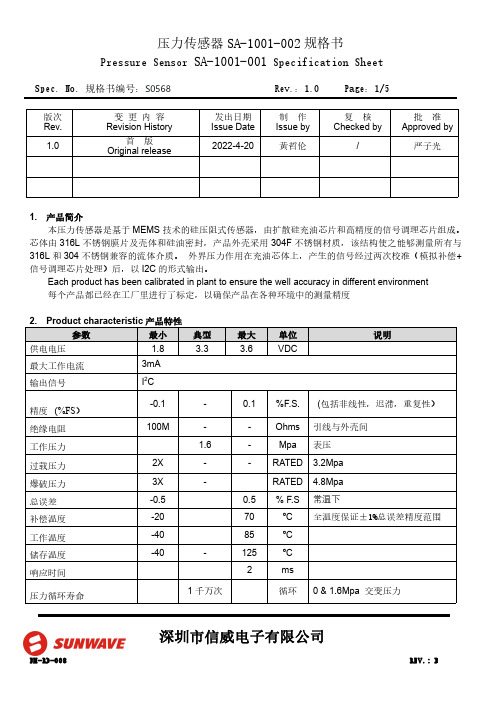
Spec.No.规格书编号:S0568Rev.:1.0Page:1/5深圳市信威电子有限公司版次Rev.变更内容Revision History发出日期Issue Date 制作Issue by 复核Checked by批准Approved by 1.0首版Original release2022-4-20黄哲伦/严子光1.产品简介本压力传感器是基于MEMS 技术的硅压阻式传感器,由扩散硅充油芯片和高精度的信号调理芯片组成。
芯体由316L 不锈钢膜片及壳体和硅油密封,产品外壳采用304F 不锈钢材质,该结构使之能够测量所有与316L 和304不锈钢兼容的流体介质。
外界压力作用在充油芯体上,产生的信号经过两次校准(模拟补偿+信号调理芯片处理)后,以I2C 的形式输出。
Each product has been calibrated in plant to ensure the well accuracy in different environment 每个产品都已经在工厂里进行了标定,以确保产品在各种环境中的测量精度Spec.No.规格书编号:S0568Rev.:1.0Page:2/5深圳市信威电子有限公司3.输出接口及管脚定义注:1.产品的内部电路已经在I2C 总线上放置了4.7K 的上拉电阻2.所有管脚与产品的金属外壳之间是绝缘的4.产品外形结构(单位:mm )5.功能描述5.1.工作模式传感器的默认工作模式为:产品上电后,进入到休眠状态,仅在接收到相应的I2C 命令后才会启动一次压力和温度的测量动作,之后再次自动进入休眠状态,以节省功耗。
5.2.上电启动及休眠唤醒当电源电压小于0.2V 时,传感器处于复位状态,在电源电压以最低10V/ms 的上升速率经过1ms 的延迟后,I2C 接口处于正常状态,可以接受主机命令,在经过2.5ms 的延迟后,传感器可以进行正常的压力和温度测量。
当传感器处于休眠状态时,在接收到主机命令后的0.5ms 时间内从休眠状态进入到工作模式,详细请参Spec.No.规格书编号:S0568Rev.:1.0Page:3/5深圳市信威电子有限公司照上电时序图6.I2C 接口6.1.I2C 接口电气特性在产品内部,I2C 总线的时钟信号线和数据线已经具有4.7k 的上拉电阻6.2.I2C 通讯速率本传感器的I2C 接口可工作于标准模式(100Kbit/s )、快速模式(400Kbit/s)、和高速模式(3.4Mbit/s)。
压力传感器应用场景
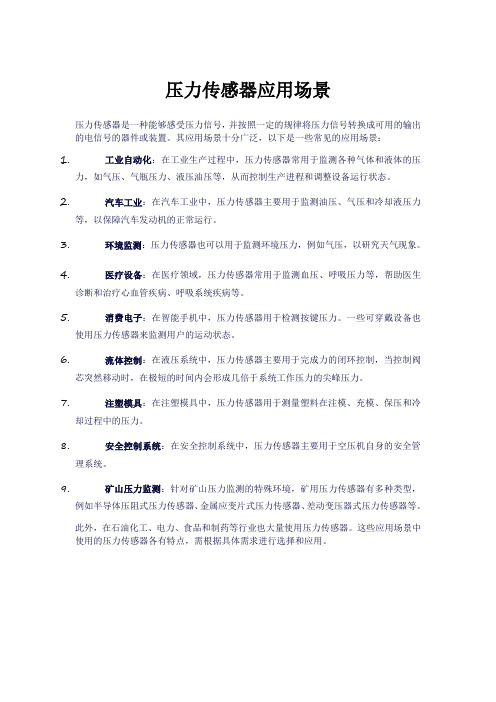
压力传感器应用场景
压力传感器是一种能够感受压力信号,并按照一定的规律将压力信号转换成可用的输出的电信号的器件或装置。
其应用场景十分广泛,以下是一些常见的应用场景:
1.工业自动化:在工业生产过程中,压力传感器常用于监测各种气体和液体的压
力,如气压、气瓶压力、液压油压等,从而控制生产进程和调整设备运行状态。
2.汽车工业:在汽车工业中,压力传感器主要用于监测油压、气压和冷却液压力
等,以保障汽车发动机的正常运行。
3.环境监测:压力传感器也可以用于监测环境压力,例如气压,以研究天气现象。
4.医疗设备:在医疗领域,压力传感器常用于监测血压、呼吸压力等,帮助医生
诊断和治疗心血管疾病、呼吸系统疾病等。
5.消费电子:在智能手机中,压力传感器用于检测按键压力。
一些可穿戴设备也
使用压力传感器来监测用户的运动状态。
6.流体控制:在液压系统中,压力传感器主要用于完成力的闭环控制,当控制阀
芯突然移动时,在极短的时间内会形成几倍于系统工作压力的尖峰压力。
7.注塑模具:在注塑模具中,压力传感器用于测量塑料在注模、充模、保压和冷
却过程中的压力。
8.安全控制系统:在安全控制系统中,压力传感器主要用于空压机自身的安全管
理系统。
9.矿山压力监测:针对矿山压力监测的特殊环境,矿用压力传感器有多种类型,
例如半导体压阻式压力传感器、金属应变片式压力传感器、差动变压器式压力传感器等。
此外,在石油化工、电力、食品和制药等行业也大量使用压力传感器。
这些应用场景中使用的压力传感器各有特点,需根据具体需求进行选择和应用。
传感器分类及20种常见传感器
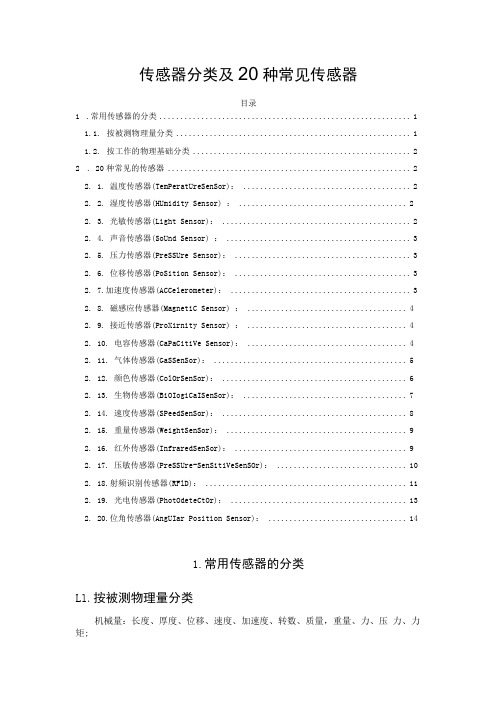
传感器分类及20种常见传感器目录1.常用传感器的分类 (1)1.1.按被测物理量分类 (1)1.2.按工作的物理基础分类 (2)2. 20种常见的传感器 (2)2. 1. 温度传感器(TemPeratUreSenSor): (2)2. 2. 湿度传感器(HUmidity Sensor) : (2)2. 3. 光敏传感器(Light Sensor): (2)2. 4. 声音传感器(SoUnd Sensor) : (3)2. 5. 压力传感器(PreSSUre Sensor): (3)2. 6. 位移传感器(PoSition Sensor): (3)2. 7.加速度传感器(ACCelerometer): (3)2. 8. 磁感应传感器(MagnetiC Sensor) : (4)2. 9. 接近传感器(ProXirnity Sensor) : (4)2. 10. 电容传感器(CaPaCitiVe Sensor): (4)2. 11. 气体传感器(GaSSenSor): (5)2. 12. 颜色传感器(ColOrSenSor): (6)2. 13. 生物传感器(BiOIogiCaISenSor): (7)2. 14. 速度传感器(SPeedSenSor): (8)2. 15. 重量传感器(WeightSenSor): (9)2. 16. 红外传感器(InfraredSenSor): (9)2. 17. 压敏传感器(PreSSUre-SenSitiVeSenSOr): (10)2. 18.射频识别传感器(RFlD): (11)2. 19. 光电传感器(PhotOdeteCtOr): (13)2. 20.位角传感器(AngUIar Position Sensor): (14)1.常用传感器的分类Ll.按被测物理量分类机械量:长度、厚度、位移、速度、加速度、转数、质量,重量、力、压力、力矩;声:声压、噪声;温度:温度、热量、比热;磁:磁通、磁场;光:亮度、色彩。
微压力传感器原理及应用

微压力传感器原理及应用微压力传感器(Micro Pressure Sensor)是一种能够测量微小压力变化的传感器。
它通过测量压力对传感器的弹性材料产生的变形,将压力转化为电信号输出,用于监测和测量各种应用场景中的微小压力变化。
微压力传感器的工作原理主要包括弹性材料变形原理、电阻变化原理和电桥原理。
首先,微压力传感器使用了一种具有较高弹性的材料,例如硅胶或金属弹簧。
当受到微压力作用时,这种材料会发生弹性变形,如压缩或伸展。
通过测量弹性材料的变形量,就可以间接测量压力的大小。
其次,微压力传感器还采用了电阻变化原理。
在传感器的弹性材料上涂覆了一层导电薄膜,当受到压力后,弹性材料的变形会导致导电薄膜的长度和面积发生变化,从而改变了电阻值。
通过测量电阻的变化,可以得到压力的信息。
最后,微压力传感器还可以利用电桥原理来实现。
通过将传感器的弹性材料作为电桥电路的一部分,使得压力的作用会改变电桥的平衡状态,从而引起电桥输出电压的变化。
通过检测电桥输出电压的变化,可以得到与压力变化相关的电信号。
微压力传感器广泛应用于医疗、汽车、电子设备、工业等领域。
以下是一些典型的应用场景:1.医疗健康领域:微压力传感器可以用于各种医疗设备中,如呼吸机、血压计、体重秤等。
通过测量微小压力变化,可以监测患者的生命体征,提供准确的医学数据。
2.汽车领域:微压力传感器可以用于汽车发动机的排放控制系统、制动系统和轮胎气压监测等。
通过监测发动机内部压力和轮胎气压的变化,可以实时调整汽车系统的运行状态,提高汽车的性能和安全性。
3.电子设备领域:微压力传感器可以用于智能手机、平板电脑等电子设备中,用于实现触摸屏的压力感应。
通过识别用户的不同触摸力度,可以实现更精准的交互操作。
4.工业领域:微压力传感器可以用于工业流程控制、压力传递和泄漏检测等。
例如,在石油化工过程中,可以利用微压力传感器实时监测管道内部的压力变化,避免泄漏事故的发生。
总之,微压力传感器通过测量微小压力变化,可以实时监测和测量各种应用场景中的压力情况,并将其转化为电信号输出,为各行各业提供准确的数据支持。
水压传感器工作原理

水压传感器工作原理水压传感器(Pressure Sensor)是一种能够测量液体或气体压力的装置,广泛应用于工业控制、环境监测、仪器仪表等领域。
本文将介绍水压传感器的工作原理及其应用。
一、水压传感器的工作原理水压传感器通过将水压转换成电信号来实现对压力的测量。
主要由压力感应器和信号处理电路组成。
1. 压力感应器压力感应器是水压传感器的核心部件,一般采用绝缘膜或金属薄膜等材料制成。
当外界施加压力时,感应器内的薄膜会发生微小形变,形变后的薄膜将引起电阻或电容等特性的变化。
- 绝缘膜压力传感器:绝缘膜传感器一般采用硅微机电系统(MEMS)技术制造。
其工作原理是当压力施加到绝缘膜上时,绝缘膜上的应变将导致电阻值的变化,通过测量电阻值的变化来确定压力值。
- 金属薄膜压力传感器:金属薄膜传感器使用金属薄膜的应变来测量压力。
当压力施加到金属薄膜上时,金属薄膜将发生微小应变,导致电阻值的改变。
通过测量电阻值的变化,可以得到压力的数值。
2. 信号处理电路信号处理电路是将压力感应器输出的电阻值或电容值转换成标准信号(通常为电压信号)的部分。
其目的是将感应器的信号放大、线性化并加以滤波和稳定,以得到精确的压力数值。
二、水压传感器的应用水压传感器具有广泛的应用领域,下面将介绍其在几个主要领域的应用。
1. 工业控制水压传感器在工业过程控制中起着重要的作用。
通过对压力变化的监测,可以实时掌握工业设备状态,进行智能控制。
例如,在水泵系统中,水压传感器可以监测水压变化并及时反馈给控制系统,实现对水泵的智能控制。
2. 环境监测水压传感器在环境监测领域有着广泛应用。
例如,地下水位监测中,水压传感器可以测量井下水压变化,实时监测地下水位的变化情况。
同时,水压传感器还可以应用于天气预测、地震监测等环境监测领域。
3. 仪器仪表水压传感器在各种仪器仪表中的应用也非常广泛。
例如,在汽车的制动系统中,水压传感器可以实时监测刹车油液的压力,以确保制动系统的可靠性和安全性。
发动机八大传感器作用简洁解释

发动机八大传感器作用简洁解释发动机是现代汽车的核心组件之一,它负责产生动力,并驱动车辆行驶。
然而,发动机的正常运行和性能表现不仅依赖于其内部构造和机械部件,还依赖于一系列关键的传感器。
这些传感器扮演着监测和控制发动机运行的重要角色。
在本文中,我们将深入探讨发动机的八大传感器的作用,以帮助读者更好地理解和利用这些关键部件。
1. 氧气传感器(O2传感器)氧气传感器监测发动机排气中的氧气含量。
通过检测排气中的氧气水平,氧气传感器能够判断燃烧过程的质量,并根据需要调整燃油供应以实现最优的燃烧效率。
它有助于减少废气排放和提高燃油经济性。
2. 曲轴位置传感器(Crankshaft Position Sensor)曲轴位置传感器用于检测发动机曲轴的旋转速度和位置。
它提供发动机转速的关键信息,以便控制点火系统和燃油喷射系统的操作。
通过准确测量曲轴位置,曲轴位置传感器确保点火系统按时点火,以实现最佳的动力输出。
3. 曲轴相位传感器(Crankshaft Phase Sensor)曲轴相位传感器用于测量曲轴的旋转相位。
通过监测曲轴相位,曲轴相位传感器可以帮助控制发动机的点火和喷射时机,并调整气缸内压强的分布。
它对于发动机的节能、减排和动力输出都起着至关重要的作用。
4. 凸轮轴位置传感器(Camshaft Position Sensor)凸轮轴位置传感器用于检测发动机凸轮轴的位置和速度。
凸轮轴位置传感器的作用类似于曲轴位置传感器,但它专门用于控制凸轮轴的操作,以确保气门的开闭时间和幅度与发动机控制系统的要求相匹配。
5. 气体温度传感器(Intake Air Temperature Sensor)气体温度传感器测量进气道中的空气温度。
准确的气体温度信息对于燃烧过程的控制和发动机性能至关重要。
气体温度传感器可以帮助调整燃油喷射量和点火时机,以适应不同的气温条件。
6. 大气压力传感器(Manifold Absolute Pressure Sensor)大气压力传感器测量进气道中的绝对压力。
Festo SPAU 2 压力传感器说明书
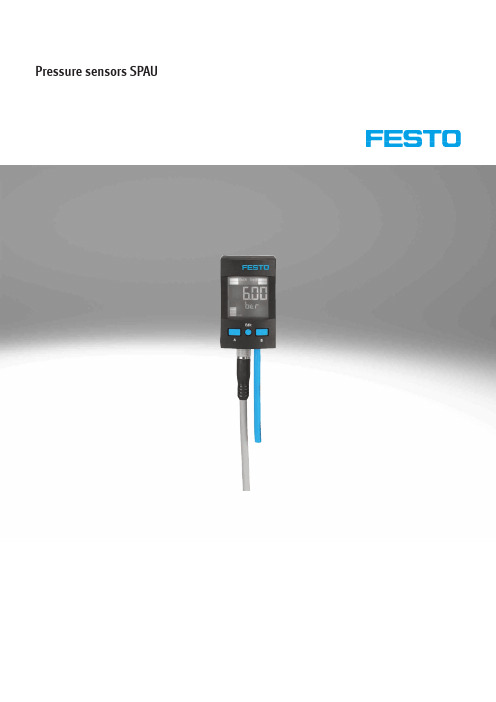
Pressure sensors SPAUPressure sensors SPAU CharacteristicsAt a glanceProduct descriptionThe pressure sensor SPAU is suitable for monitoring compressed air and non- corrosive gases. The variant with display offers the option of reading the pressure and set values on-site. The pressure value is transmitted to the connected control system as a switching signal, as an analogue signal or via IO-Link.The pressure sensor without display transmits the pressure value to the connect-ed control system as an analogue signal. Display of the pressure and parameteri-sation of the sensor are provided centrally, e.g. via a display that is part of a ma-chine control system. The pressure sensor can be parameterised using IO-Link asa tamper-proof pressure switch without display with up to two switching outputs.Areas of application• Network monitoring (pressure present)• Regulator monitoring (pressure in the setpoint range)• Vacuum (part picked up)• Leak test (pressure drop over time)• Object detection (back pressure present)Product benefitsA mounting concept that is quick tomount and that is easy to implement inall installation situations. Female/malethread or push-in fitting QS – theperfect pneumatic adapter for everyapplication.Mounting:• Threaded mounting• H-rail mounting• Front panel mounting• Mounting bracket• Wall mounting• Adapter to MS4, MS6Electronics:• Maximum versatility and reducedwarehousing thanks to switchableelectrical outputs (PNP/NPN/N/Ccontact/N/O contact and current/voltage output)2d Internet: /catalogue/...Subject to change – 2022/01Pressure sensors SPAU CharacteristicsOperationMonitoring and setting of a pressurethreshold, a pressure range or apressure difference, using a teach-infunction or by entering values.Variants with display:• Pressure indicator, pressure switch-ing outputs and analogue value out-put from a device can be set on-site • Quick commissioning of the pres-sure sensor thanks to straightfor-ward menu navigation• Display colour blue/red as visual feedback about the pressure of the medium • Min./max. value memory for moni-toring compressed air (display ofrapid pressure peaks that are notvisible to the human eye)• Adjustable filter evens out the sen-sor signal generated by pressurepeaks• Scaling the analogue output toincrease the signal dynamics• Choice of pressure units: bar, MPa,PSI and more• Offset compensation possible• ECO function "Switch off display"available• Optional security code can be freelychosen (4-digit code)• All the settings for one sensor (mas-ter) can be transferred (replication)to other, identical sensors (device).This significantly shortens thecommissioning timeVariants without display:• Analogue value output and pressure switching outputs proportional to the pressure • Switching output behaviour can beset on the machine display usingIO-Link• Other functions can be set usingIO-LinkVariants with IO-Link:• With and without display• Serial communication integrated using IO-Link 1.1• Analogue process value is provided digitally • The sensor can be parameterisedand maintained remotely at controllevel using an IO-Link master• Automatic parameterisation follow-ing a sensor change means there isno need to re-parameterise or enterthe settings again after changingthe sensor32022/01 – Subject to change d Internet: /catalogue/...Pressure sensors SPAU CharacteristicsThe connections shown are by way of example.Variants with display and MS adapter4d Internet: /catalogue/...Subject to change – 2022/01Pressure sensors SPAU CharacteristicsDevice variantsVariants without displayThe connections shown are by way of example.5 2022/01 – Subject to change d Internet: /catalogue/...Pressure sensors SPAUCharacteristics1)Threaded mounting with M5 female thread not recommended6d Internet: /catalogue/...Subject to change – 2022/01Pressure sensors SPAU Peripherals overview117 2022/01 – Subject to change d Internet: /catalogue/...Pressure sensors SPAUType codes8d Internet: /catalogue/...Subject to change – 2022/0192022/01 – Subject to changed Internet: /catalogue/...Pressure sensors SPAUData sheetDisplay … -LVariant without display Voltage output preset… -LK-VVariant without display Current output preset… -LK-A-P- Voltage 20 ... 30 V DC-L-Pressure measuring range –1 ... +16 bar -Q-Temperature range0 ... +50°CPressure sensors SPAUData sheet1)Second PNP output can only be activated using IO-Link1)0 ... 10 V analogue output can only be activated using IO-Link2) 1 ... 5 V analogue output can only be activated using IO-Link3) 4 ... 20 mA analogue output can only be activated using IO-Link10d Internet: /catalogue/...Subject to change – 2022/011)Corrosion resistance class CRC 2 to Festo standard FN 940070Moderate corrosion stress. Indoor applications in which condensation can occur. External visible parts with primarily decorative surface requirements which are in direct contact with a normal industrial environment.[1]M5Only with type of mounting A, F.[2]Q4, Q6, T532Not with type of mounting T.Not with pressure measuring range P16.[3]M, F Mandatory information in combination with pneumatic connection G18, N18, R18, R14, M7, M5.[4]M Not with type of mounting H, W, MS4, MS6.Not with pneumatic connection Q4, Q6, T532, M7, M5.[5]F Not with type of mounting A if pneumatic connection G18, R18, N18.Not with type of mounting MS4, MS6.Not with pneumatic connection Q4, Q6, Q532.[6]Not with type of mounting W, H.Not with thread type F if pneumatic connection G18, R18, N18.[7]D Not with pneumatic connection M5.Not with type of mounting A, MS4, MS6.Not with thread type M.[8]L Mandatory information in combination with type of mounting F, MS4, MS6.[9]LK, V, B, A Not with display L.[10]PNLK, PNVBA Not without display.[11]Only with type of mounting A, F.Not with pneumatic connection G18, N18, R18, M7, M5.Not with outlet orientation D, U.Only with thread type "without".[12]D Mandatory information in combination with type of mounting MS4, MS6.Only with outlet orientation D if pneumatic connection Q4 or T532 selected.Not with outlet at rear if pneumatic connection Q4, Q6, T532.[13]U Only with outlet orientation U if pneumatic connection Q4 or T532 selected.Not with outlet at rear if pneumatic connection Q4, Q6, T532.[15]R14Only with thread type M.Outlet at rear only.Not with type of mounting W, H.Not with electrical outlet at rear.[16]G Only with display L.[17]F Only with type of mounting MS4, MS6.Accessories Mounting bracket SAMH-PU-AType of mounting: via through-hole and screwMaterial:High-alloy stainless steelNote on materials: RoHS-compliant Only for variants with: pneumaticconnection with outlet at rear1) Corrosion resistance class 2 to Festo standard 940 070Components subject to moderate corrosion stress. External visible parts with primarily decorative surface requirements which are in direct contact with a normal industrial environment or media such as coolants or lubricating agents. Wall mounting SAMH-PU-WType of mounting: via through-hole Material:High-alloy stainless steelNote on materials: RoHS-compliant Only for variants with: pneumaticconnection with outlet underneath1)Corrosion resistance class CRC 2 to Festo standard FN 940070Moderate corrosion stress. Indoor applications in which condensation can occur. External visible parts with primarily decorative surface requirements which are in direct contact with a normal industrial environment.Pressure sensors SPAU Accessories – Ordering dataSafety guard SACC-PU-Gto protect the display and controlelements Material: PA Note on materials: RoHS-compliantOnly for variants with: display1)Corrosion resistance class CRC 2 to Festo standard FN 940070Moderate corrosion stress. Indoor applications in which condensation can occur. External visible parts with primarily decorative surface requirements which are in direct contact with a normal industrial environment.21 2022/01 – Subject to change d Internet: /catalogue/...Pressure sensors SPAUAccessories22d Internet: /catalogue/...Subject to change – 2022/01Festo - Your Partner in AutomationConnect with us/socialmedia 1Festo Inc.2Festo Pneumatic 3Festo Corporation 4Regional Service Center 5300 Explorer DriveMississauga, ON L4W 5G4CanadaAv. Ceylán 3,Col. Tequesquináhuac 54020 Tlalnepantla, Estado de México1377 Motor Parkway Suite 310Islandia, NY 117497777 Columbia Road Mason, OH 45040Festo Customer Interaction CenterTel:187****3786Fax:187****3786Email:*****************************Multinational Contact Center 01 800 337 8669***********************Festo Customer Interaction Center180****3786180****3786*****************************S u b j e c t t o c h a n g e。
《压力传感器》课件

压力传感器的应用
医疗设备领域
血压计:测量血压,监控血压 变化
呼吸机:监测呼吸频率和深度, 调整呼吸参数
心电图仪:监测心脏活动,诊 断心脏疾病
麻醉机:监测麻醉剂浓度,确 保麻醉效果和安全性
其他应用领域
医疗领域:用于监测血压、心电图等生理参数 汽车领域:用于监测轮胎压力、发动机油压等 航空航天领域:用于监测飞机、火箭等飞行器的压力参数 工业领域:用于监测工业设备的压力参数,如液压系统、气压系统等
对未来发展的展望与建议
技术发展趋势:智能化、微型化、集成化 应用领域拓展:医疗、汽车、航空航天等 研发投入:加大研发投入,提高技术水平 市场推广:加强市场推广,提高产品知名度
THANK YOU
汇报人:PPT
传感器技术发展趋势:智能化、 微型化、集成化
传感器应用领域:汽车、医疗、 工业、消费电子等
传感器市场前景:市场规模持 续增长,竞争激烈
未来展望:传感器技术不断创 新,应用领域不断拓展,市场 前景广阔
总结与展望
总结本次PPT内容重点
压力传感器的定义和分类 压力传感器的工作原理和结构 压力传感器的应用领域和案例 压力传感器的发展趋势和挑战
线性度:压力传感器的线性度是指其输出信号与输入信号的线性关系,通常用百分比 表示。
重复性:压力传感器的重复性是指其输出信号在相同条件下的重复性,通常用百分比 表示。
稳定性:压力传感器的稳定性是指其输出信号在长时间内保持稳定的能力,通常用百 分比表示。
压力传感器的用途

现在的人们对于外界的感知不仅仅只是限制于自己的感觉,我们有许多的传感器来向我们传递外界的相关信息。
而压力传感器就是其中一种。
压力传感器(Pressure Transducer)是能感受压力信号,并能按照一定的规律将压力信号转换成可用的输出的电信号的器件或装置。
压力传感器通常由压力敏感元件和信号处理单元组成。
按不同的测试压力类型,压力传感器可分为表压传感器、差压传感器和绝压传感器。
压力传感器是工业实践中最为常用的一种传感器,其广泛应用于各种工业自控环境,涉及水利水电、铁路交通、智能建筑、生产自控、航空航天、军工、石化、油井、电力、船舶、机床、管道等众多行业。
压力传感器主要应用于:增压缸、增压器、气液增压缸、气液增压器、压力机,压缩机,空调制冷设备等领域。
1、应用于液压系统压力传感器在液压系统中主要是来完成力的闭环控制。
当控制阀芯突然移动时,在极短的时间内会形成几倍于系统工作压力的尖峰压力。
在典型的行走机械和工业液压中,如果设计时没有考虑到这样的极端工况,任何压力传感器很快就会被破坏。
需要使用抗冲击的压力传感器,压力传感器实现抗冲击主要有2种方法,一种是换应变式芯片,另一种方法是外接盘管,一般在液压系统中采用第一种方法,主要是因为安装方便。
此外还有一个原因是压力传感器还要承受来自液压泵不间断的压力脉动。
2.应用于安全控制系统压力传感器在安全控制系统中经常应用,主要针对的领域是空压机自身的安全管理系统。
在安全控制领域有很多传感器应用,压力传感器作为一种非常常见的传感器,在安全控制系统中应用也不足为奇。
在安全控制领域应用一般从性能方面来考虑,从价格上的考虑,还有从实际操作的安全性方便性来考虑,实际证明选择压力传感器的效果非常好。
压力传感器利用机械设备的加工技术将一些元件以及信号调节器等装置安装在一块很小的芯片上面。
所以体积小也是它的优点之一,除此之外,价格便宜也是它的另一大优点。
在一定程度上它能够提高系统测试的准确度。
气压传感器工作原理

气压传感器工作原理气压传感器(Pressure Sensor)是一种能够测量和转化气体压力变化的装置。
它在各个领域都有广泛的应用,如工业控制、汽车制造、医疗设备等。
本文将介绍气压传感器的工作原理,包括其基本结构和工作原理的详细解析。
一、气压传感器的基本结构气压传感器的基本结构包括传感元件和信号处理电路两个主要部分。
传感元件是气压传感器的核心部分,它负责将气体压力变化转化为与之对应的电信号。
常见的传感元件有压阻式、电容式和电感式传感器。
其中,压阻式传感器是最常见、应用最广泛的一种。
信号处理电路用于接收传感元件输出的电信号,并进行放大、滤波和线性化处理,最终输出与气体压力变化一致的电信号。
二、气压传感器的工作原理压阻式气压传感器是基于半导体材料的电阻随压力变化而产生相应变化的原理工作的。
压阻式气压传感器的基本原理是利用受压电阻的电阻值随气体压力的变化而改变,进而产生电信号。
以下是其工作原理的详细解析:1. 压阻式传感元件的结构压阻式传感元件通常由薄膜、基底和导线组成。
薄膜可以是由半导体材料或金属材料制成的。
导线连接在薄膜上,用于传递电信号。
2. 压阻式传感元件的工作原理当气压施加到传感元件表面时,薄膜会因为受到的压力不同而产生应变。
这种应变会引起薄膜电阻值的变化。
一般而言,当受到压力的作用时,薄膜电阻值的变化与受压力的大小成正比。
这是因为半导体材料或金属材料的导电性质会随着应变的发生而发生变化。
3. 信号处理电路的作用信号处理电路会将传感元件输出的电信号进行放大、滤波和线性化处理,以得到与气压变化相符的电信号。
信号处理电路中的放大器会将传感元件输出的微弱电信号放大到可测量或可操作的范围内。
滤波器则会去除干扰信号,以保证测量的准确性。
线性化处理电路则会将非线性的传感元件输出转化为线性的电信号。
最后,信号处理电路输出的电信号可供用户使用,如数码显示、控制系统等。
三、气压传感器的应用举例气压传感器的应用十分广泛。
汽车常用传感器的介绍

汽车常用传感器的介绍
1、氧气传感器(Oxygen Sensor)
氧气传感器是汽车排放控制系统中重要的传感器,它可以测量汽车排放的氧气含量,主要用于控制汽车燃油的燃烧程度,改善发动机的排放性能,保持发动机的最佳性能,节省燃油,防止汽车制动后火花塞的损坏。
氧气传感器主要为双芯控制型传感器,在冷却剂以及排气管两端各设置一个传感器,当发动机启动时,热空气从排气管中流过传感器,传感器将热空气中含有的氧气的含量发送到ECU,ECU接收到氧传感器信号后,根据发动机负荷,控制一次喷射量,调整空气燃油比例,达到最佳燃烧状态。
2、温度传感器(Coolant Temperature Sensor)
温度传感器是负责检测发动机冷却液温度的一种电子设备,它通过测量冷却液在冷却系统内的温度,以实时反馈系统温度变化的信号,从而控制发动机温度,使发动机处于最佳的工作状态,避免发动机过热或过冷的问题。
温度传感器一般安装在发动机水箱出口处,它会将发动机冷却液的温度变化信息发送到ECU,ECU根据获取到的信息调整发动机的转速,保持发动机的最佳温度状态,有效地控制汽车油耗。
3、压力传感器(Pressure Sensor)
压力传感器是汽车发动机中常用的传感器。
PressureSensor压力传感器
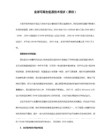
MD-S200 电池供电型数字压力表
技术参数
产品应用
耗电低,三节电池可持续工作12个月。
三种压力单位可相互切换:Mpa,PSI,Kg/cm2。
4位液晶显示屏,实时显示压力变化。
内置压力传感器,压力精度高、寿命长、反应快、无噪音。
MD-S200电池供电型智能压力表是集压力测量、显示一体的高精度电子式压力表,具有抗震动、显示精度高、使用寿命长、可清零、自动待机等特点。
无需外接电源,电池供电时间长,具有自动待机与一键清零功能,使用方便,应用领域广泛。
技术特点
◇ 水处理系统 ◇ 水泵及空气压缩机 ◇ 机电设备自动化 ◇ 工程机械
◇ 医疗设备 ◇ 液压与气动系统
◇ 实验室 ◇ 测试架
手机:189******** QQ:2908093293
100
24
20。
感应式压力传感器P500的产品说明说明书

| P500PRESSURE SENSOR DescriptionFeatures• Small Size (3/4” Hex)• External Hex for Easy Installation • Linear Amplified Output • Temperature Compensated • Superior Long-Term Stability • Low Power Consumption• Minimum Life Expectancy: Ten Million CyclesThe P500 incorporates Kavlico’s 4th generation ceramic capacitive sense element with the latest state of the art proprietary ASIC. Available in brass or stainless steel housings, this multi-purpose sensor is rugged by design. Highly reliable, the P500 is ideal for measuring a broad range of process media including hydrocarbon based fluids, air, and gases. The P500 package has a built-in Metri-Pack 150 series sealed electrical connector and is available with popular pressure connection thread options. The sensor is offered with seal materials suitable for diverse applications. Standard pressure ranges are available in PSI or Bar.Applications• Compressors • Process Controls• Instruments & Test Equipment • Sterilizers • Air Pressure• Oil & Fuel Pressure • Coolant Pressure• Agricultural Equipment• CNG & Natural Gas EnginesSPECIFICATIONSTECHNICAL SPECIFICATIONSPressure RangesPhysicalPerformanceElectricalPART NUMBER DESIGATION: P500-300-S-E 4 AVoutputN/CVsupplyGNDVENT HOLE (GAUGE)USE STANDARD OPENEND WRENCH OR SPECIALIZED SOCKET WRENCH ONLY19.1818.69.755.736HEXDATE CODE EXAMPLE: L0515UL LOGO (PRESSURE DEPENDENT)KAVLICO PART #(SEE EXAMPLE)PERMANENTLY IDENTIFY X X X X XDATE CODE11P500-XXX-X-X4XSHOWN19.09 1.575 MAX.752405.59.220Dimensions in mm [Inch]DIMENSIONSPressure Sensor with Electrical ConnectionPressure Connections and Recommended Installation Torque1/4 - 18 NPT 1/8 - 27 NPT Stud EndDIN 3852-B-G1/4External External External 25 Nm20 Nm20 NmTapped Hole DIN 3852-Y-G1/43/8-24 UNF-2A PER SAE J 1926/23/8-24 UNF-2B PER SAE J 1926/1Internal External Internal 15 Nm22 Nm22 NmPage 4CONTACT USAmericas+1 (800) 350 2727***************************************Europe, Middle East & Africa +359 (2) 809 1826****************************Asia Pacific*************************.com China +86 (21) 2306 1500Japan +81 (45) 277 7117Korea +82 (31) 601 2004India +91 (80) 67920890Rest of Asia +886 (2) 27602006 ext 2808Sensata Technologies, Inc. (“Sensata”) data sheets are solely intended to assist designers (“Buyers”) who are developing systems that incorporate Sensata products (also referred to herein as “components”). Buyer understands and agrees that Buyer remains responsible for using its independent analysis, evaluation and judgment in designing Buyer’s systems and products. Sensata data sheets have been created using standard laboratory conditions and engineering practices. Sensata has not conducted any testing other than that specifically described in the published documentation for a particular data sheet. Sensata may make corrections, enhancements, improvements and other changes to its data sheets or components without notice.Buyers are authorized to use Sensata data sheets with the Sensata component(s) identified in each particular data sheet. HOWEVER, NO OTHER LICENSE, EXPRESS OR IMPLIED, BY ESTOPPEL OR OTHERWISE TO ANY OTHER SENSATA INTELLECTUAL PROPERTY RIGHT, AND NO LICENSE TO ANY THIRD PARTY TECHNOLOGY OR INTELLECTUAL PROPERTY RIGHT, IS GRANTED HEREIN. SENSATA DATA SHEETS ARE PROVIDED “AS IS”. SENSATA MAKES NO WARRANTIES OR REPRESENTATIONS WITH REGARD TO THE DATA SHEETS OR USE OF THE DATA SHEETS, EXPRESS, IMPLIED OR STATUTORY, INCLUDING ACCURACY OR COMPLETENESS. SENSATA DISCLAIMS ANY WARRANTY OF TITLE AND ANY IMPLIED WARRANTIES OF MERCHANTABILITY, FITNESS FOR A PARTICULAR PURPOSE, QUIET ENJOYMENT, QUIET POSSESSION, AND NON-INFRINGEMENT OF ANY THIRD PARTY INTELLECTUAL PROPERTY RIGHTS WITH REGARD TO SENSATA DATA SHEETS OR USE THEREOF.All products are sold subject to Sensata’s terms and conditions of sale supplied at SENSATA ASSUMES NO LIABILITY FOR APPLICATIONS ASSISTANCE OR THE DESIGN OF BUYERS’ PRODUCTS. BUYER ACKNOWLEDGES AND AGREES THAT IT IS SOLELY RESPONSIBLE FOR COMPLIANCE WITH ALL LEGAL, REGULATORY AND SAFETY-RELATED REQUIREMENTS CONCERNING ITS PRODUCTS, AND ANY USE OF SENSATA COMPONENTS IN ITS APPLICATIONS, NOTWITHSTANDING ANY APPLICATIONS-RELATED INFORMATION ORDERING OPTIONSP500 Sensor, 0 - 16 Bar Absolute, Fluorosilicone Seal Material, 1/4 - 18 NPTA: With Mating Connector, w/12”, 18 AWG Leads C: Without Mating ConnectorAGENCY APPROVALS & CERTIFICATIONSEN 61326-1, 2006IEC 61000-4-2, 2001IEC 61000-4-3, 2006IEC 61000-4-8, 20012002/95/EC RoHS Directive File # SA10552。
- 1、下载文档前请自行甄别文档内容的完整性,平台不提供额外的编辑、内容补充、找答案等附加服务。
- 2、"仅部分预览"的文档,不可在线预览部分如存在完整性等问题,可反馈申请退款(可完整预览的文档不适用该条件!)。
- 3、如文档侵犯您的权益,请联系客服反馈,我们会尽快为您处理(人工客服工作时间:9:00-18:30)。
Pressure Sensor 压力传感器一.外型图片
二.工作原理
抗腐蚀的陶瓷压力传感器没有液体的传递,压力直接作用在陶瓷膜片的前表面,使膜片产生微小的形变,厚膜电阻印刷在陶瓷膜片的背面,连接成一个惠斯通电桥(闭桥),由于压敏电阻的压阻效应,使电桥产生一个与压力成正比的高度线性、与激励电压也成正比的电压信号,标准的信号根据压力量程的不同标定为2.0 / 3.0 / 3.3 mV/V等,可以和应变式传感器相兼容。
通过激光标定,传感器具有很高的温度稳定性和时间稳定性,传感器自带温度补偿0~70℃,并可以和绝大多数介质直接接触。
陶瓷是一种公认的高弹性、抗腐蚀、抗磨损、抗冲击和振动的材料。
陶瓷的热稳定特性及它的厚膜电阻可以使它的工作温度范围高达-40~135℃,而且具有测量的高精度、高稳定性。
电气绝缘程度>2kV,输出信号强,长期稳定性好。
高特性,低价格的陶瓷传感器将是压力传感器的发展方向,在欧美国家有全面替代其它类型传感器的趋势,在中国也越来越多的用户使用陶瓷传感器替代扩散硅压力传感器。
三.选型主参数
a)首先要问客户其具体的工作环境,如钢厂,机械加工厂,造船厂等,根据不同的应
用环境来选与之相对应的产品
b)压力量程:这是最基本也最重要的参数,因为毕竟是测量压力范围的。
一般会取一
个上限值,如:40bar ,100bar ,600bar等等
c)输出信号:因为我们是压力传感器,应用之目的就是为了完好对所控制量的监视和
控制,所以Sensor 一般会具有开光量(Switch Output)和模拟量输出(Analog
Output),模拟又分国际标准的信号:电压输出(Voltage Output 0-10V) 电流输出
(Current Output:4-20MA)
d)机械连接规格:因为传感器要与对方的容器相连接,所以连接罗纹规格也是个比
较重要的数据,如果规格不符,则无法安装上去。
一般规格:G1/4,G1/2,NPT1/4
M18X1.5 等等。
e)电气接头形式:依据不同的信号个数来选择之。
四.应用场合
造船行业,机械加工,移动起重机,钢铁行业,港口机械
液压实验室等等。
